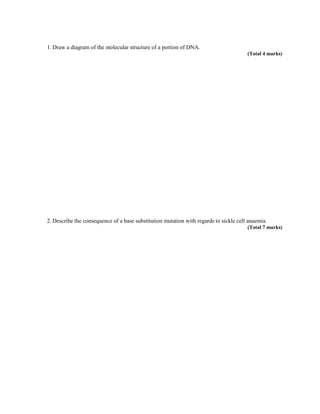Bio past years qs
- 1. 1. Draw a diagram of the molecular structure of a portion of DNA. (Total 4 marks) 2. Describe the consequence of a base substitution mutation with regards to sickle cell anaemia. (Total 7 marks)
- 2. 3. Outline the production of a dipeptide by a condensation reaction. Include the structure of a generalized dipeptide in your answer. (Total 5 marks) 4. Explain the process of translation. (Total 9 marks)
- 3. 5. List four functions of proteins, giving an example of each. (Total 4 marks) 6. Describe the significance of water to living organisms. (Total 6 marks) 7. Outline the role of condensation and hydrolysis in the relationship between amino acids and dipeptides. (Total 4 marks)
- 4. . Up to two additional marks are available for the construction of your answers. (2) 8. (a) Draw and label a mitochondrion as seen in electron micrographs. (4) (b) Outline the cellular locations of different named processes in both photosynthesis and cell respiration. (6) (c) Explain the energy flow in a food chain as exemplified by a pyramid of energy. (8) (Total 20 marks)
- 5. 9. Explain the process of aerobic respiration including oxidative phosphorylation. (Total 8 marks) 10. Draw a diagram showing the molecular structure of a section of the DNA molecule. (Total 5 marks) 11. Outline the process of translation. (Total 5 marks)
- 6. 12. Explain the effects of temperature, pH and substrate concentration on enzyme activity. (Total 8 marks) 13. List the functions of membrane proteins. (Total 4 marks) 14. Explain the similarities and differences in anaerobic and aerobic cellular respiration. (Total 8 marks)
- 7. 15. Describe the use of carbohydrates and lipids for energy storage in animals. (Total 5 marks) 16. Sickle cell anemia is a serious disease caused by a single base substitution mutation. Explain how a single base substitution mutation can have significant consequences for an individual. (Total 6 marks) 17. Outline enzyme-substrate specificity. (Total 5 marks)
- 8. 18. Explain how allosteric control of metabolic pathways by end-product inhibition includes negative feedback and non-competitive inhibition. (Total 8 marks) 19. Distinguish between fibrous and globular proteins, giving one example of each. (Total 5 marks) 20. State a role for each of four different named enzymes in DNA replication. (Total 6 marks)
- 9. 21. Explain how the light-independent reactions of photosynthesis rely on light-dependent reactions. (Total 8 marks) 22. Outline the effect of temperature, light intensity and carbon dioxide concentration on the rate of photosynthesis. (Total 6 marks)
- 10. 23. The structure of the DNA double helix was described by Watson and Crick in 1953. Explain the structure of the DNA double helix, including its subunits and the way in which they are bonded together. (Total 8 marks) 24. Compare DNA transcription with translation. (Total 4 marks)
- 11. 25. Explain the reactions involving the use of light energy that occur in the thylakoids of the chloroplast. (Total 8 marks)











